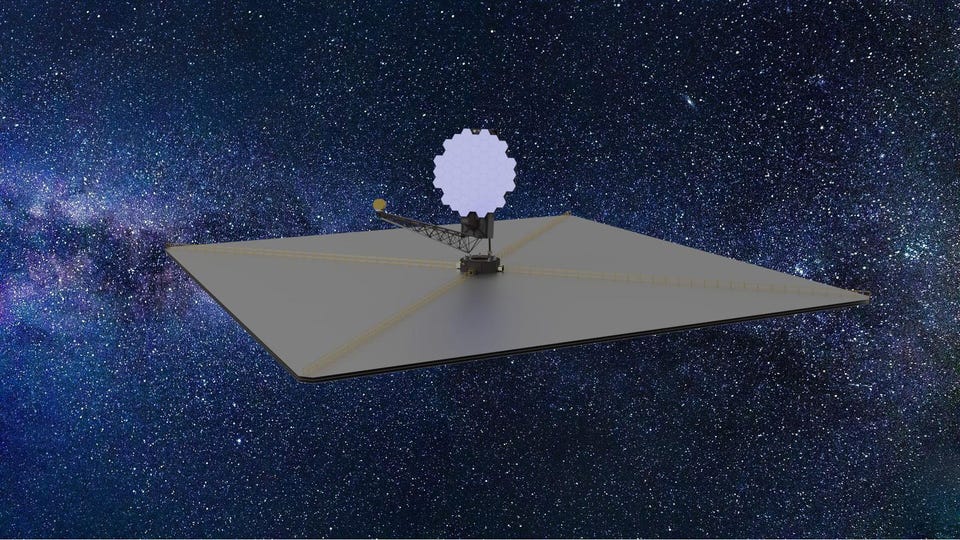Science Webb: Why NASA’s New ‘Ultimate Space Telescope’ Means The Future Is Flat-Packed Jamie Carter Senior Contributor Opinions expressed by Forbes Contributors are their own. I inspire people to go stargazing, watch the Moon, enjoy the night sky New! Follow this author to improve your content experience. Got it! Jul 12, 2022, 08:00pm EDT | Share to Facebook Share to Twitter Share to Linkedin Could NASA’s next great space telescope look something like this concept for the LUVOIR-B .
. . [+] observatory? NASA GSFC The James Webb Space Telescope (JWST) was hugely expensive, a massively ambitious engineering project and, as proven by this week’s “first light” images , a complete success.
It’s now a blueprint for all future space telescopes, all of which will be even bigger and better. We could even be entering a new era of robotic structures that self-assemble in space. Here’s what the success of the Webb telescope means for the future of space telescopes and more besides: 1.
All future space telescopes will be foldable (and larger) The great challenge for engineers working on Webb was how to get a space telescope with a 21 feet/6. 5 meter mirror—the largest ever launched to space—into the 5. 4 meter/17.
7ft. fairing of the Ariane 5 for launch—the largest rocket fairing NASA could find. It was done using all kinds of engineering “origami” that saw the mirror split into 18 segments.
“NASA wanted a big space telescope, but was limited by the size of the rocket shrouds, so we had to figure out how to fold these things up—and that means making them segmented,” said Erin Elliott, Principal R&D Engineer – Optical at Zemax Ansys, who worked on the software to align Webb’s primary mirror segments while at the Space Telescope Institute. “The folding technology was an epic investment that sets us up even for the next huge space telescopes, which will be even larger. ” Rocket fairings will get much bigger very soon.
SpaceX’s Starship can fit cargo measuring nine meters in diameter and 18 meters high. However, now that the foldable space telescope has been proven expect all future space telescopes to be based on Webb’s brave design. It’s thus now the blueprint.
MORE FROM FORBES VETTED 21 Amazon Prime Day Robot Vacuum Deals That Are Already Live By Sholeen Damarwala Forbes Staff 36 Prime Day Competitor Sales With Way Better Deals Than Amazon By Ciannah Gin Forbes Staff That will include a suite of new giant space telescopes that are now in the conceptual stage of development such as LUVOIR , HabEx , Origins and Lynx . SpaceX’s Starship can fit cargo measuring 9 meters in diameter and 18 meters high. Getty Images 2.
Webb has begun an era of self-assembling structures After multiple large deployments and movements, with thousands of parts working correctly in sequence, Webb unfolded in space to get into its final configuration. It did so while it traveled to its final destination over 30 days in January 2022. “JWST means that we have also begun working on how to assemble large structures in space,” said Elliot.
“You can think of JWST as a telescope robot, in a sense, that put itself together on orbit. ” For JWST, there was a lot of assistance from the ground at Webb’s Mission Operations Center at the Space Telescope Science Institute in Baltimore, Maryland. Even that alignment software had a human in the loop at every step, but the future is automation.
“How do we get the human out of the loop and fully automate the assembly, can we operate general-purpose robots that assemble structures for us and can we create structures that completely assemble themselves?” said Elliot. “JWST is a big first step toward all of these. ” As well as space telescopes that could mean modules, space ships and space stations as our species goes inter-planetary, as envisaged by MIT’s TESSERAE (Tessellated Electromagnetic Space Structures for the Exploration of Reconfigurable, Adaptive Environments) project.
3. Space telescopes will use sunshields, not coolant NASA’s Spitzer space telescope—launched in 2003—exhausted its supply of the liquid helium coolant necessary for operating two of its three infrared instruments. “We said from the start the Webb had to be passively cooled so it doesn’t die when it runs out of coolant,” said Elliot.
“It’s a huge limitation of infrared missions—Spitzer’s strategic shutdown was heartbreaking for the scientists involved even though we all knew it was coming. : JWST is passively cooled by a kite-shaped sunshield membrane. Always positioned between the telescope’s optics and the Sun, it comprises five super-thin layers of Kapton E with aluminum and doped-silicon coatings to reflect the Sun’s heat.
It’s bigger than three tennis courts. It’s got hinges, motors, gears, springs—and 1,312 ft. of cables.
No fewer than 107 myriad release mechanisms were needed to fire on cue to separate and align the five layers. It was risky, but it worked. “The thermal design was very carefully done to get it to the right temperature, which it achieved,” said Elliot.
“We’re thrilled about that and now this new technology is proved out. ” Webb has ushered in a new era of highly advanced space telescopes where the basic blueprint is for foldable robotic machines that fold-up for launch, self-assemble in space and cool-down without using any fuel. Wishing you clear skies and wide eyes.
Follow me on Twitter or LinkedIn . Check out my website or some of my other work here . Jamie Carter Editorial Standards Print Reprints & Permissions.
From: forbes
URL: https://www.forbes.com/sites/jamiecartereurope/2022/07/12/webb-why-nasas-new-ultimate-space-telescope-means-the-future-is-flat-packed/



